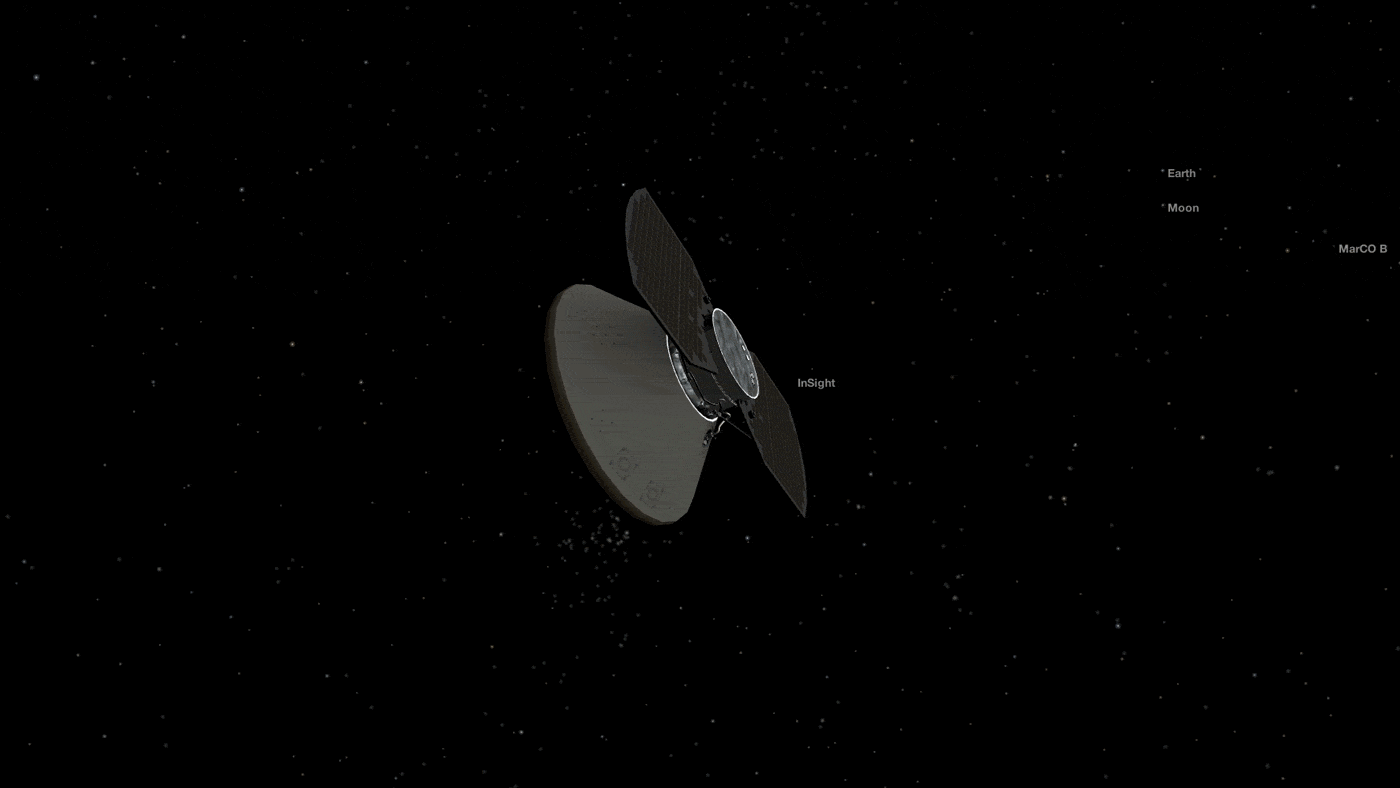
NASA / JPL - CalTech
InSight Steers Toward Mars (News Release - May 23)
NASA's InSight lander has made its first course correction toward Mars.
InSight, short for Interior Exploration using Seismic Investigations, Geodesy and Heat Transport, is the first mission dedicated to exploring the deep interior of Mars.
The lander is currently encapsulated in a protective aeroshell, which launched on top of an Atlas V 401 rocket on May 5 from Vandenberg Air Force Base in Central California. Yesterday, the spacecraft fired its thrusters for the first time to change its flight path. This activity, called a trajectory correction maneuver, will happen a maximum of six times to guide the lander to Mars.
Every launch starts with a rocket. That's necessary to get a spacecraft out past Earth's gravity -- but rockets don't complete the journey to other planets. Before launch, every piece of hardware headed to Mars is cleaned, limiting the number of Earth microbes that might travel on the spacecraft. However, the rocket and its upper stage, called a Centaur, don’t get the same special treatment.
As a result, Mars launches involve aiming the rocket just off-target so that it flies off into space. Separately, the spacecraft performs a series of trajectory correction maneuvers guiding it to the Red Planet. This makes sure that only the clean spacecraft lands on the planet, while the upper stage does not come close.
Precise calculations are required for InSight to arrive at exactly the right spot in Mars' atmosphere at exactly the right time, resulting in a landing on Nov. 26. Every step of the way, a team of navigators estimates the position and velocity of the spacecraft. Then they design maneuvers to deliver it to an entry point at Mars. That navigation team is based at NASA's Jet Propulsion Laboratory in Pasadena, California, which leads the InSight mission.
"This first maneuver is the largest we'll conduct," said Fernando Abilleira of JPL, InSight's Deputy Mission Design and Navigation Manager. "The thrusters will fire for about 40 seconds to impart a velocity change of 3.8 meters per second (8.5 mph) to the spacecraft. That will put us in the right ballpark as we aim for Mars."
Especially at the beginning of that cruise, navigators rely on NASA's Deep Space Network (DSN) to track the spacecraft. The DSN is a system of antennas located at three sites around the Earth. As the planet rotates, each of these sites comes into range of NASA's spacecraft, pinging them with radio signals to track their positions. The antennas also send and receive data this way.
The DSN can give very accurate measurements about spacecraft position and velocity. But predicting where InSight will be after it fires its thrusters requires lots of modeling, Abilleira said. As the cruise to Mars progresses, navigators have more information about the forces acting on a spacecraft. That lets them further refine their models. Combined with DSN tracking measurements, these models allow them to precisely drive the spacecraft to the desired entry point.
"Navigation is all about statistics, probability and uncertainty," Abilleira said. "As we gather more information on the forces acting on the spacecraft, we can better predict how it's moving and how future maneuvers will affect its path."
Yesterday's 40-second burn relies on four of eight thrusters on the spacecraft. A separate group of four is autonomously fired on a daily basis to keep the spacecraft's solar panels trained on the Sun and its antennas pointed at Earth. While necessary to maintain orientation, these small, daily firings also introduce errors that navigators have to account for and counterbalance.
"Everyone has been working hard since launch to assess what these small forces have done to the trajectory," said Allen Halsell of JPL, InSight's navigation team chief. "People have worked lots of hours to look at that. For engineers, it's a very interesting problem, and fun to try to figure out."
When the spacecraft is just a few hours from Mars, the planet's gravitational pull, or gravity well, will begin to reel the spacecraft in. At that point, InSight's team will prepare for the next milestone after cruise: entering Mars' atmosphere, descending to the surface and sticking InSight's landing.
JPL, a division of Caltech in Pasadena, California, manages InSight for NASA's Science Mission Directorate in Washington. InSight is part of NASA's Discovery Program, managed by the agency's Marshall Space Flight Center in Huntsville, Alabama. The InSight spacecraft, including cruise stage and lander, was built and tested by Lockheed Martin Space in Denver.
Source: Jet Propulsion Laboratory

No comments:
Post a Comment